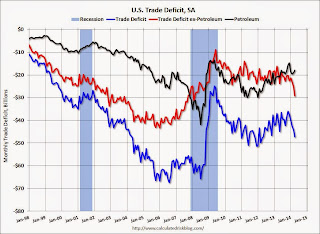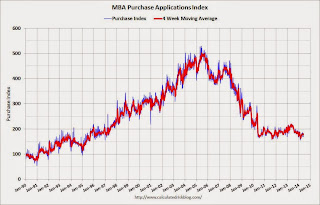by Calculated Risk on 6/04/2014 10:00:00 AM
Wednesday, June 04, 2014
ISM Non-Manufacturing Index increased in May to 56.3
The May ISM Non-manufacturing index was at 56.3%, up from 55.5% in April. The employment index increased in May to 52.4%, up from 51.3% in April. Note: Above 50 indicates expansion, below 50 contraction.
From the Institute for Supply Management: May 2014 Non-Manufacturing ISM Report On Business®
Economic activity in the non-manufacturing sector grew in May for the 52nd consecutive month, say the nation's purchasing and supply executives in the latest Non-Manufacturing ISM® Report On Business®.
The report was issued today by Anthony Nieves, CPSM, C.P.M., CFPM, chair of the Institute for Supply Management® (ISM®) Non-Manufacturing Business Survey Committee. "The NMI® registered 56.3 percent in May, 1.1 percentage points higher than April are reading of 55.2 percent. This represents continued growth at a faster rate in the Non-Manufacturing sector and is the highest reading for the index since August 2013, when the index registered 57.9 percent. The Non-Manufacturing Business Activity Index increased to 62.1 percent, which is 1.2 percentage points higher than the April reading of 60.9 percent, reflecting growth for the 58th consecutive month at a faster rate. The New Orders Index registered 60.5 percent, 2.3 percentage points higher than the reading of 58.2 percent registered in April. The Employment Index increased 1.1 percentage points to 52.4 percent from the April reading of 51.3 percent and indicates growth for the third consecutive month and at a faster rate. The Prices Index increased 0.6 percentage point from the April reading of 60.8 percent to 61.4 percent, indicating prices increased at a faster rate in May when compared to April. According to the NMI®, 17 non-manufacturing industries reported growth in May. The majority of respondents' comments indicate that that there is steady incremental growth and project a positive outlook on business conditions."
emphasis added
 Click on graph for larger image.
Click on graph for larger image.This graph shows the ISM non-manufacturing index (started in January 2008) and the ISM non-manufacturing employment diffusion index.
This was above the consensus forecast of 55.3% and suggests faster expansion in May than in April.
Trade Deficit increased in April to $47.2 Billion
by Calculated Risk on 6/04/2014 08:30:00 AM
The Department of Commerce reported this morning:
[T]otal April exports of $193.3 billion and imports of $240.6 billion resulted in a goods and services deficit of $47.2 billion, up from $44.2 billion in March, revised. April exports were $0.3 billion less than March exports of $193.7 billion. April imports were $2.7 billion more than March imports of $237.8 billion.The trade deficit was much larger than the consensus forecast of $41.0 billion.
The first graph shows the monthly U.S. exports and imports in dollars through April 2014.
 Click on graph for larger image.
Click on graph for larger image.Both imports and exports increased in April.
Exports are 17% above the pre-recession peak and up 3% compared to April 2013; imports are about 4% above the pre-recession peak, and up about 5% compared to April 2013.
The second graph shows the U.S. trade deficit, with and without petroleum, through April.
 The blue line is the total deficit, and the black line is the petroleum deficit, and the red line is the trade deficit ex-petroleum products.
The blue line is the total deficit, and the black line is the petroleum deficit, and the red line is the trade deficit ex-petroleum products.Oil imports averaged $95.48 in April, up from $93.91 in March, and down from $97.74 in April 2013. The petroleum deficit has generally been declining and is the major reason the overall deficit has declined since early 2012.
The trade deficit with China increased to $27.3 billion in April, from $24.2 billion in April 2013. More than half of the trade deficit is related to China.
Overall it appears trade is picking up slightly.
ADP: Private Employment increased 179,000 in May
by Calculated Risk on 6/04/2014 08:21:00 AM
Private sector employment increased by 179,000 jobs from April to May according to the May ADP National Employment Report®. ... he report, which is derived from ADP’s actual payroll data, measures the change in total nonfarm private employment each month on a seasonally-adjusted basis.This was below the consensus forecast for 210,000 private sector jobs added in the ADP report.
...
Mark Zandi, chief economist of Moody’s Analytics, said, "Job growth moderated in May. The slowing in growth was concentrated in Professional/Business Services and companies with 50-999 employees. The job market has yet to break out from the pace of growth that has prevailed over the last three years.”
Note: ADP hasn't been very useful in directly predicting the BLS report on a monthly basis, but it might provide a hint. The BLS report for May will be released on Friday.
MBA: Mortgage Applications Decrease in Latest Survey, Mortgage Rates "lowest levels in close to a year"
by Calculated Risk on 6/04/2014 07:01:00 AM
From the MBA: Mortgage Applications Decrease in Latest MBA Weekly Survey
Mortgage applications decreased 3.1 percent from one week earlier, according to data from the Mortgage Bankers Association’s (MBA) Weekly Mortgage Applications Survey for the week ending May 30, 2014. This week’s results include an adjustment for the Memorial Day holiday. ...
The Refinance Index decreased 3 percent from the previous week. The seasonally adjusted Purchase Index decreased 4 percent from one week earlier. ...
...
Interest rates for most products fell to their lowest levels in close to a year.
The average contract interest rate for 30-year fixed-rate mortgages with conforming loan balances ($417,000 or less) decreased to 4.26 percent from 4.31 percent, with points decreasing to 0.13 from 0.15 (including the origination fee) for 80 percent loan-to-value ratio (LTV) loans.
emphasis added
 Click on graph for larger image.
Click on graph for larger image.The first graph shows the refinance index.
The refinance index is down 73% from the levels in May 2013 (one year ago).
As expected, refinance activity is very low this year.
 The second graph shows the MBA mortgage purchase index.
The second graph shows the MBA mortgage purchase index. According to the MBA, the unadjusted purchase index is down about 17% from a year ago.
Note: It appears mortgage rates will be down year-over-year in a few weeks.
Tuesday, June 03, 2014
Wednesday: ADP Employment, Trade Deficit, ISM Service, Beige Book
by Calculated Risk on 6/03/2014 06:45:00 PM
From Jon Hilsenrath at the WSJ: Fed Officials Growing Wary of Market Complacency
[M]easures of risk aversion and market volatility show an especially striking sense of investor calm. The VIX, which tracks expected stock-market fluctuations based on options trading, has gone 74 straight weeks below its long-run average—a run of steadiness not seen since 2006 and 2007."Complacency" may be a problem, but this isn't 2006 and 2007. In January 2007 I predicted a recession would start that year as a result of the housing bust (made it by one month since the recession started in December 2007!). Now - I don't see a recession any time soon.
...
New York Fed President William Dudley warned in a question-and-answer session after a speech last month that he was nervous that unusually low volatility in markets was breeding too much risk-taking.
Wednesday:
• At 7:00 AM ET, the Mortgage Bankers Association (MBA) will release the results for the mortgage purchase applications index.
• At 8:15 AM, the ADP Employment Report for May. This report is for private payrolls only (no government). The consensus is for 210,000 payroll jobs added in May, down from 220,000 in April.
• At 8:30 AM, the Trade Balance report for April from the Census Bureau. The consensus is for the U.S. trade deficit to be at $41.0 billion in April from $40.4 billion in March.
• At 10:00 AM, the ISM non-Manufacturing Index for May. The consensus is for a reading of 55.3, up from 55.2 in April. Note: Above 50 indicates expansion.
• At 2:00 PM, the Federal Reserve Beige Book, an informal review by the Federal Reserve Banks of current economic conditions in their Districts.


